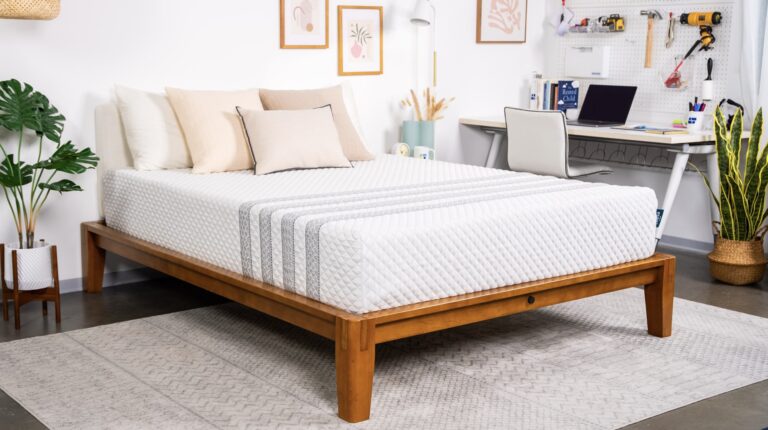When you buy through our links, we may earn a commission. Products or services may be offered by an affiliated entity. Learn more.
Nectar vs. Leesa Mattress Comparison

Nectar Classic
Bottom Line
The Nectar is a plush and adaptive all-foam mattress that offers excellent pressure relief and motion isolation.
Save 50% on mattresses & 66% on bundles
Full Mattress ReviewVS

Leesa Original
Bottom Line
The Leesa Original features a mixed-foam design that contours to your body without sinking too much or hindering movement.
25% off all mattresses
Full Mattress ReviewLeesa and Nectar are two direct-to-consumer mattress brands founded in 2015 and 2017, respectively. Both companies launched with a flagship all-foam bed. The Nectar Classic is a 12-inch memory foam model with a medium firm feel, while the Leesa Original is a 10-inch memory foam model with a slightly softer feel. They are also available as hybrid mattresses.
Both companies offer a full range of other mattresses for different sleeping styles, along with bedding and bed frames. But in this article, we’ll be comparing the Nectar Classic and the Leesa Original, with a focus on their construction and how it affects the performance and feel. We’ll also look at each company’s shipping, sleep trial, and warranty policies to help you choose between the two.
Quick Look
$649 – $1,249
$639 – $2,079
Medium Firm (6)
Medium (5), Medium Firm (6)
- Memory foam cushions and cradles the body to reduce pressure points
- Excellent motion isolation for couples
- Responsive yet cushioning mixed-foam designs
- Ideal conforming and support for many sleepers weighing up to 230 lbs.
- 365 nights (30-night requirement)
- Lifetime, Limited
- 100 nights (30 night requirement)
- Lifetime, limited
- A+
- A+
Our Testing Team’s Take
Our Seattle Test Lab is our headquarters for in-depth mattress analysis. In the lab, our team has evaluated more than 2,000 mattresses using the same intensive methodology for finding each model’s strengths and weaknesses.
Part of that methodology is based on quantifying aspects of mattress performance. With specialized equipment, we measure metrics like surface motion transfer, joint and pressure relief, and mattress temperature.
But our testing doesn’t stop with objective data. Our team members take mattresses home with them for field testing to see how they feel in an actual bedroom environment. We get feedback from testers with different sleep positions and body weights, giving us a wider perspective that informs our mattress reviews and helps you identify the best mattress for your bedroom.
Our Verdict
The Leesa and the Nectar are both all-foam mattresses, so they share some similarities. Both perform well on motion isolation and less well on edge support and ease of movement. Foam mattresses are known for trapping heat, and while both brands have taken steps to mitigate heat retention, the Leesa performs slightly better on this front.

Jeremy Klein
Senior Product Testing Manager
Side sleeper
160 lbs.
Nightly melatonin user
“The Leesa Original feels comfortable right off the bat. When lying on my side, I felt moderate contouring of my shoulders and hips, and I woke up without any aches or pains.”
The Nectar is quite a lot firmer than the Leesa, making it a clear choice for back sleepers. While both mattresses offer pressure relief for side sleepers, the Leesa has a cushier feel that will appeal to people under 130 pounds.

Colin Simpson
Product Research Manager
Side sleeper
190 lbs.
Talks in sleep (like a lot)
“I enjoyed the Nectar. I felt well-supported and my shoulders and hips were nicely cushioned as I laid on my side. There was a really nice coziness to it. On the other hand, I did sleep hotter than in my usual bed. I was kicking the covers off throughout the night.”
Shoppers in Alaska and Hawaii benefit from free shipping with Leesa, which may sway your decision if you live in these states since free shipping is hard to find. On the other hand, Nectar offers a full year-long sleep trial, one of the longest on the market, so you can get a sense of how the mattress performs in all four seasons before reaching a decision. The Nectar also has a more attractive price point.
Construction and Materials
The Nectar and the Leesa are both all-foam models with polyfoam and memory foam comfort layers over a foam support core.
| Construction Analysis | Nectar Classic | Leesa Original |
|---|---|---|
| Cover | Polyester blend | 87% polyester, 13% viscose |
| Comfort Layer | 1” memory foam | 2” polyfoam |
| Transitional Layer | 3″ polyfoam | 2″ memory foam |
| Support Core | 8″ polyfoam | 6″ polyfoam |
Nectar Classic Breakdown
The 12” Nectar Classic has a cooling cover and a medium firm (6) feel, falling at a 6 out of 10 on our firmness scale. Medium firm is generally accepted as the firmness that appeals to the widest range of sleepers, as it offers a fairly neutral balance between support and pressure relief.
A thin, 1-inch layer of memory foam supplies a light layer of cushioning. This is bolstered by a 3-inch layer of polyfoam, which is a little firmer and acts as a bridge to the support layer by cradling the body to encourage healthy spinal alignment. An 8-inch polyfoam core adds further support.
The Nectar Classic is also available in a hybrid version. This model also measures 12 inches thick but swaps out the polyfoam support core for pocketed coils with a reinforced perimeter. Hybrid mattresses are a good option for people who sleep hot and those who like to move around in bed.
Leesa Original Breakdown
Like the Nectar, the Leesa Original is an all-foam mattress. The Leesa has a standard 10-inch build with a medium (5) feel. The grey knit cover is made with a polyester-viscose blend designed to sleep cool.
As you climb into bed you’ll first encounter a 2-inch layer of polyfoam, which has a quicker response to pressure than memory foam so you don’t feel stuck. Below this is a 2-inch layer of memory foam for deep cushioning of areas like the hips and shoulders, which is handy when lying on your side.
A 6-inch polyfoam support core lends structure to the bed and ensures that the hips don’t sink too far into the bed. In this manner, the support core promotes healthy sleep posture for fewer aches and pains. If you prefer, you can buy the Leesa Original in a hybrid version, which uses pocketed coils in the support core instead of polyfoam.
Mattress Sizing and Weight
The Nectar is slightly thicker and heavier than the Leesa, although the hybrid versions are comparable. Both mattresses are sold in the six standard sizes, and the Nectar is additionally available in split king size.
| Mattress Model | Profile | Weight (Queen) |
|---|---|---|
| Nectar Classic | 12” | 83 lbs. |
| Leesa Original | 10” | 71 lbs. |
Performance Ratings
The Nectar and the Leesa offer solid pressure relief for side sleepers, with the Leesa best suited to side sleepers under 130 pounds and the Nectar best for side sleepers between 130 and 230 pounds. Back sleepers also receive solid lower back support from the Nectar’s medium firm surface.
Thanks to the memory foam, the mattresses also do a great job of blocking motion transfer so couples who share a bed can sleep uninterrupted. With its slightly firmer feel, the Nectar offers a stronger perimeter so you feel more stability when sleeping close to the edge of the bed. On the other hand, hot sleepers will gravitate toward the Leesa, which offers better temperature regulation.
Though still more responsive than traditional memory foam models, neither the Leesa nor the Nectar is what you would call a bouncy mattress. If you’re a combination sleeper or you just like the freedom to move around in bed, you may prefer their hybrid options.
Mattress Pricing
While both mattresses are competitively priced, the Nectar is one of the most affordable mattresses on the market. For each company, the hybrid option costs more than the all-foam model.
| Policy | Nectar Classic | Leesa Original |
|---|---|---|
| Sleep Trial | 365 nights (30-night requirement) | 100 nights (30-night break-in period) |
| Warranty | Lifetime, limited | Lifetime, limited |
| Shipping | Free to contiguous U.S., $250 fee for Alaska and Hawaii | Free to all 50 states |
| White Glove Delivery | Available for a fee | Available for a fee |
What Customers Are Saying
On both the Nectar and the Leesa, couples say they’re able to sleep soundly without waking up every time their partner moves. Some people mention the edges are too weak to use the full surface of the bed. A few shoppers note that the Nectar and the Leesa develop body indentations after about four or five years.
Combination sleepers appreciate that while the Leesa provides cushioning, you don’t sink too far into the bed and it’s still relatively easy to switch positions. Some people say the mattress sleeps hot, which is common for all-foam models.
An overwhelming number of reviewers mention that the Nectar is firmer than they expected. Some people say they find the bed supportive, while others — especially side sleepers weighing less than 130 pounds — say it gives them sore spots. Hot sleepers are divided on the cooling features.

Still have questions? Ask our community!
Join our Sleep Care Community — a trusted hub of product specialists, sleep health professionals, and people just like you. Whether you’re searching for the perfect mattress or need expert sleep advice, we’ve got you covered. Get personalized guidance from the experts who know sleep best.






